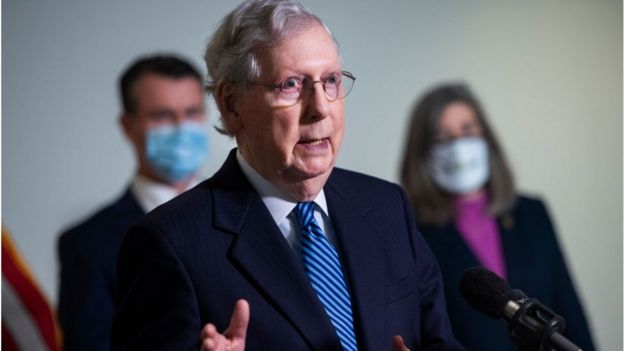US: Replacement to Ruth Bader Ginsburg by week’s end

President Trump has said he will name a replacement to Ruth Bader Ginsburg by week’s end and urged the Republican-controlled Senate to confirm his Supreme Court choice before 3 November.
The plan has launched a high-stakes battle ahead of the election.
Mr Trump would replace Ginsburg, a liberal stalwart who died on Friday aged 87, with a conservative.
The president appears to have secured enough support in the US Senate to win approval for his nominee.
This would cement a right-leaning majority on the court for decades.
The ideological balance of the nine-member court is crucial to its rulings on the most important issues in US law.
What happens next?
On Monday, the president signalled he would nominate a replacement on “Friday or Saturday”, after memorial services for Ginsburg.
“The bottom line is we won the election, we have an obligation to do what’s right and act as quickly as possible,” Mr Trump told Fox News.
On Monday, the president had a private meeting at the White House with a potential nominee: Amy Coney Barrett, an appeals court judge in Chicago. She is also backed by anti-abortion conservatives.
Once the president names a nominee, it is the Senate’s job to vote on whether to confirm them. The Judiciary Committee will review the pick first, and then vote to send the nominee to the floor for a full vote.
Senate majority leader Mitch McConnell has vowed to hold a confirmation vote before the election in November.
Democrats have accused Mr McConnell and the Republicans of hypocrisy.
Following the death of conservative justice Anthony Scalia in 2016, Mr McConnell refused to hold a vote to confirm a nominee put forward by then-President Barack Obama, a Democrat.

Mr Obama had nominated Merrick Garland in February of that year – months before the election – but Mr McConnell argued that Supreme Court justices should not be approved in an election year.
In 2017, Mr McConnell also changed Senate rules to allow for a simple majority (51 votes) to confirm nominees.
However, this time around, with a president of the same party, the Senate leader says because the Senate and White House are both Republican-held, unlike 2016, the nomination should proceed.
Do Senate Republicans have the votes?
The Republican president’s plan to appoint a justice was boosted on Monday after two closely watched senators of his party, Cory Gardner of Colorado and Charles Grassley of Iowa, signalled they backed moving ahead.
Their support may grant Republicans the 50 votes they need to confirm a justice, given that Vice-President Mike Pence can cast a tie-breaking vote if needed.
Republicans hold a slim 53-47 majority in the upper chamber.
Lindsey Graham, the powerful Republican chairman of the Senate Judiciary committee, said on Monday he would be “leading the charge to make sure that President Trump’s nominee has a hearing, [and] goes to the floor of the United States Senate for a vote”.
Mitt Romney, of Utah, remains undecided. Susan Collins of Maine and Lisa Murkowski of Alaska, have backed a delay in the vote.
Ms Collins said she had “no objection” to the process of reviewing a candidate beginning now, but that she did not believe the Senate should vote on the candidate before November’s election. Ms Collins is facing a tough re-election bid this year.
Ms Murkowski said she “did not support taking up a nomination eight months before the 2016 election” and believed the “same standard must apply” now.
Even if Republicans lose their Senate majority on 3 November, the new Congress does not take office until 3 January, which would give them time to confirm Mr Trump’s pick.
If the nominee is not confirmed by 20 January, Inauguration Day, they would have to be re-nominated by the president (whoever that ends up being).



